Browse Primary Sources
Locate primary sources, including images, objects, media, and texts. Annotations by scholars contextualize sources.
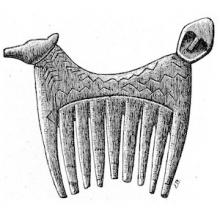
Bone comb
Historians and archeologists can learn a great deal from artifacts such as this comb that may date from the Neolithic or Late Stone Age. Items found near the artifact can help provide context such as when the artifact was created and what it might have been used for. This comb, carved from bone, was found on the island of Gotland which is presently part of Sweden.
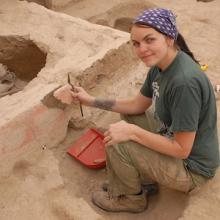
Excavation at Çatalhöyük, Turkey
The excavation at Çatalhöyük in southern Turkey began in 1958 and scholars continue to actively search for artifacts at the site. Items found at Çatalhöyük have shown that the site has been inhabited since Neolithic times beginning in approximately 7100 BCE. Artifacts found at Çatalhöyük include a rich collection of art including sculptures and wall paintings.

A Hindu Princess Committing Sati against the Wishes of Emperor Akbar
This 18th century painting by Mohammad Rizā Naw'ī depicts Sati, the practice whereby an elite Hindu widow would commit suicide through self-immolation upon the death of her husband. Sati was featured prominently in European depictions of Hinduism where it reinforced “exotic” stereotypes of South Asians, and was used as an excuse to justify British Imperialism.
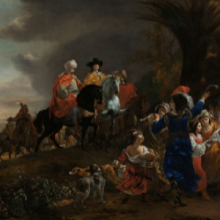
The Dutch Ambassador on his Way to Isfahan
This painting by Jan Baptist Weenix depicts the Dutch ambassador Joan Cunaeus and his secretary, Cornelis Speelman, on a diplomatic mission to Isfahan in Persia in 1651-52. The men were sent to Isfahan on behalf of the Dutch East India Company (VOC) to stimulate trade in horses and silk. Cunaeus, prominently depicted on a white horse, is wearing a silk cloak, a gift from the Shah of Persia.
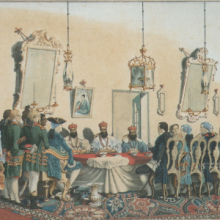
Reception of the Envoys from Kandy in Colombo
This is a 1772 image by Carel Frederik Reimer depicting the reception of representatives of the King of Kandy at the Dutch East India Company’s (VOC) governor’s house in Colombo, Ceylon (modern-day Sri Lanka). The Kingdom of Kandy was an independent polity that controlled the central and some eastern portions of the island.
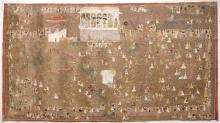
Dutch East India Company Embassy to India
This painting by an unknown artist depicts the meeting of Dutch East India Company (VOC) officials and the ruler of Udaipur, a city in the present-day Indian state of Rajasthan. The meeting was part of a VOC diplomatic mission in 1711 to the Mughal emperor Bahadur Shah to attain letters of favor and trading privileges for the Company.
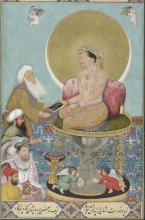
Jahangir Preferring a Sufi Shaikh to Kings
This is a painting done in the miniature style by Mughal court painter Bichitr, ca. 1615-18. The Mughal emperor Jahangir is shown holding court atop an ornate hourglass throne. The golden hourglass, European in design, highlights the global contact between Europeans and the Mughal Empire.
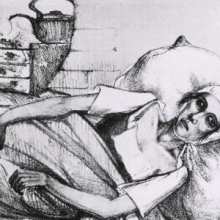
Girl who died of Cholera
This is a page from a book containing a colored lithograph (reproduced here in black and white) depicting a girl who died from cholera. The lithograph's caption, “Blue Stage of the Spasmodic Cholera.
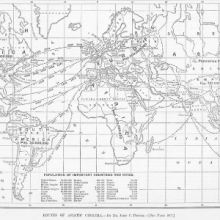
Cholera Transmission
This map, created by Dr. John C. Peters and featured in the April 25, 1885 edition of Harper's Weekly, depicts the spread of cholera throughout the world and the major cholera pandemics that occurred in the nineteenth century. Cholera is a diarrheal disease caused by the bacterium Vibrio cholerae.
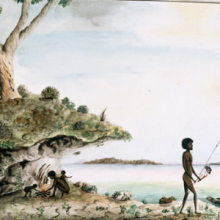
Native Going to Fish with a Torch and Flambeaux
This image is from the Watling Collection, a collection of 512 numbered drawings depicting natural history and ethnographic subjects from eighteenth-century Australia. Thomas Watling, an artist from Dumfries, Scotland, created a large portion of the collection. Some of the collection's images are by at least one other artist or artists known as the Port Jackson Painter.
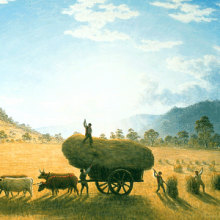
My Harvest Home
John Glover is considered to be one of the best Australian landscape painters of the early colonial period. He painted My Harvest Home in 1835 and it depicts Patterdale Farm in northern Tasmania, the farm Glover established in 1832 through a land grant from the Tasmanian Government.

Mameluke with a basket of flowers, 1641
Albert Eckhout was the first European painter in Brazil. Eckhout was an official painter, hired by Johan Maurits van Nassau-Siegen, a prince of the House of Orange. These paintings tell us much about Brazil in the first half of the seventeenth century, and but also about the activities of the Dutch, and Dutch perceptions of the colony.
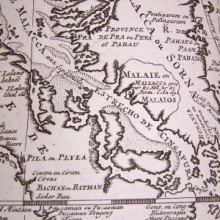
Map of Malacca, Châtelain
This is a detail of a map depicting the port of Malacca and the surrounding territories from the Atlas Historique, an expansive Dutch encyclopedia compiled by Henri Abraham Châtelain and first published between 1705 to 1720. The port sits on the northern side of the Malacca Straits, a narrow stretch of water between present-day Malaysia and the Indonesian island of Sumatra.
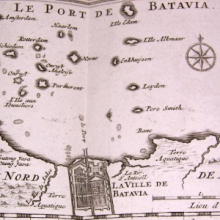
Map of Batavia, Châtelain
This is a detail of a map depicting the Dutch stronghold of Batavia from the Atlas Historique, an expansive Dutch encyclopedia compiled by Henri Abraham Châtelain and first published between 1705 to 1720.
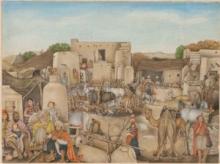
The Village of Jeewah Moocuddum near Rania
This painting, entitled The village of Jeewah Moocuddum near Rania: William Fraser’s circle of village folk, his white stallion, and progeny, is one of many paintings comprising the Fraser Album. The Fraser Album, named after its commissioner William Fraser (1784-1835), is a collection of paintings depicting various elements of life in Mughal India in the early nineteenth century.

Akbar II in darbar with the British Resident Charles Metcalfe
Attributed to the Mughal court artist, Ghulam Murtaza Khan (active 1809–30), this painting depicts British Resident Charles Metcalfe (1785-1846) in attendance at the court of Akbar II, who ruled Mughal India from 1806-37. Depicted in a monochromatic outfit with a European-style hat, Metcalfe's figure stands in sharp contrast with the colorful outfits of the court's other courtiers.
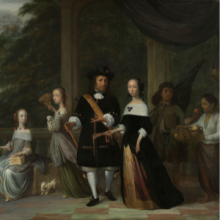
Pieter Cnoll, Batavian Senior Merchant
Painted by Jacob Coeman in 1665, this painting depicts Pieter Cnoll, his Eurasian wife Cornelia van Nijenrode, their two daughters, and two enslaved servants. Cnoll was a senior merchant of the Dutch East India Company (VOC) in Batavia (present-day Jakarta), which was the center of Dutch operations in Asia. His wife, Cornelia, was the daughter of a VOC merchant and a Japanese courtesan.
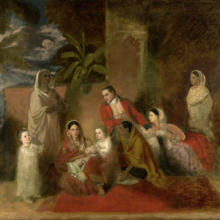
The Palmer Family
Painted by Francesco Renaldi in 1786, The Palmer Family depicts Major William Palmer (seated in the center) surrounded by his two bibis, children, and female servants. Bibis are common-law wives of British men in India. Seated to Palmer's left is Bibi Faiz Bakhsh. She is holding one of Palmer's children, a sleeping baby boy named Hastings.
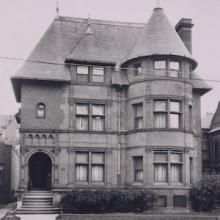
William Livingstone House
William Livingstone House. Constructed in 1893 in the once elegant Brush Park neighborhood, this home, designed by architect Albert Kahn, was moved from its original location by preservationists who hoped to maintain it. It has been since demolished.
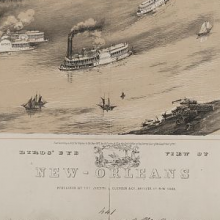
Birds-eye View of New Orleans
Created by John Bachmann, this lithographic print provides a "bird's-eye" or aerial view of the bustling city of New Orleans, Louisiana in the mid-nineteenth century. A bird's-eye view is an elevated view of an object from the imagined perspective of a bird.